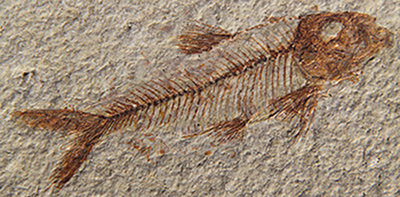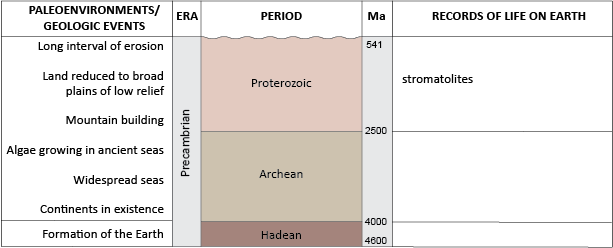
Precambrian Fossil Record
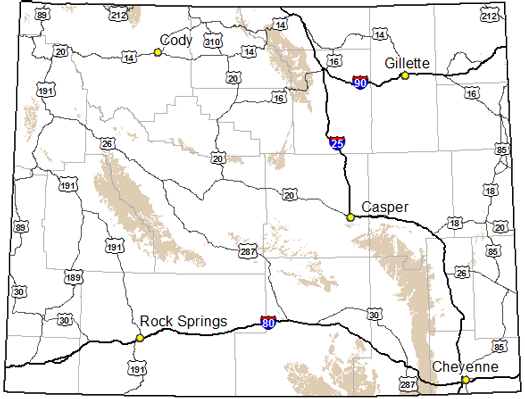
The Precambrian Era began with the formation of the earth and lasted about 3.5 billion years, which accounts for nearly 80 percent of the entire geologic time scale.
Evidence of life appears in the early Archean eon, but the fossil record at that time is rare. By the Late Archean, stromatolites (microbial mat-like structures)
started to appear in the rock record. Stromatolites are the most common Precambrian fossils.
In Wyoming, stromatolites are found in the Snowy Range (Medicine Bow Mountains) in the Nash Fork Formation of the Libby Creek Group. The stromatolites started out as microbial mats that colonized in a continental shelf environment. They are believed to have formed ~1.7 billion years ago (~1,700 Ma).
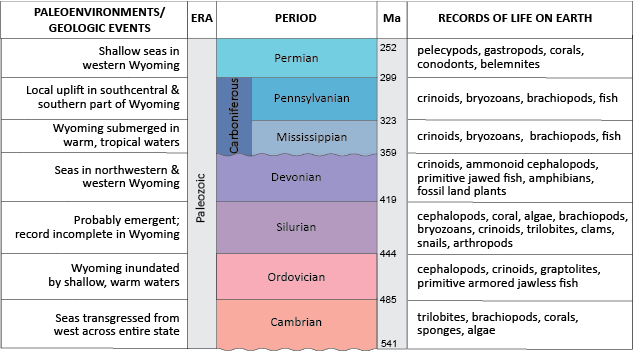
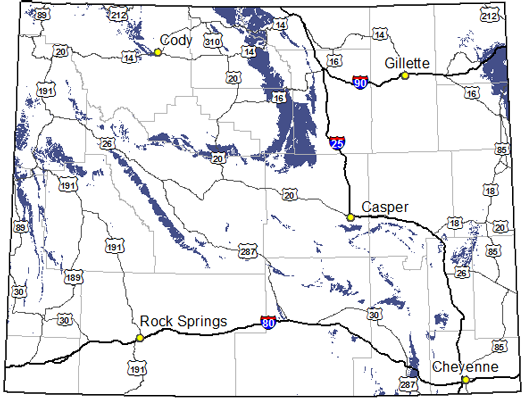
Paleozoic Fossil Record
In the Paleozoic Era, plant and animal life began to develop greater range and complexity. Insects, reptiles, fish, and invertebrates advanced during this time,
as well as vascular plant life.
Cambrian exposures in Wyoming represent a transgressive depositional sequence (sandstones overlain by shale and limestone) deposited as the sea flooded the land.
Common fossils in Cambrian units include marine flora and fauna: trilobites, brachiopods, algae, corals, and sponges.
During the Ordovician Period, Wyoming was submerged in a shallow sea. Marine fossils, such as trilobites, brachiopods, cephalopods, and primitive fish, can be found in
Ordovician formations.
The Silurian Period was a time of uplift and erosion. There are no rocks of this age in Wyoming. As such, there are no Silurian fossils. In neighboring western states,
however, a restricted distribution of poorly preserved coral fossils has been documented.
Seas transgressed and flooded the western part of Wyoming in the Devonian Period. Marine plants (crinoids) and animals (amphibians, cephalopods, and primitive fish) are
common fossils of Devonian age, as are fossil land plants.
During the Mississippian Period, Wyoming was submerged in a shallow sea and marine fossils such as trilobites, brachiopods, fish, and crinoids, are common in rocks of
this age. In the Pennsylvanian, the sea began to regress, but marine fossils are still common for this period.
In the Permian, the shallow sea continued to regress. Fossils include marine flora and fauna such as pelecypods, corals, belemnites, and conodonts, as well as gastropods.
Reptiles and coniferous trees originated during the Permian. A mass extinction marked the end of the Permian. Most of Earth's marine species and more than half of the
terrestrial reptiles, amphibians, insects, and plant life were lost.
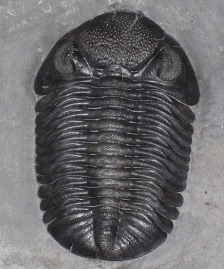


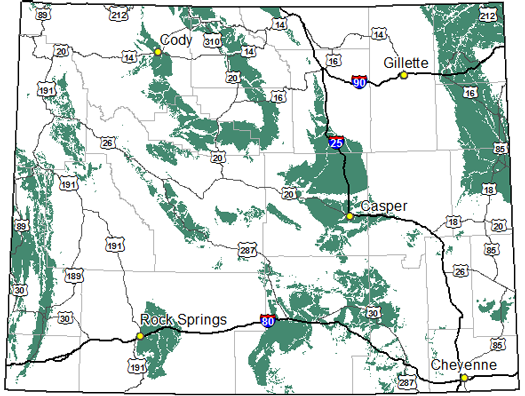
Mesozoic Fossil Record
Biodiversity increased significantly during the Mesozoic Era. The first birds and flowering plants originated during this time, as did dinosaurs and reptiles.
The Triassic Period was accompanied by a series of sea level transgressions and regressions. Common fossils are ammonites, belemnites, snails, and clams. Phytosaurs
(crocodile-like reptiles) are a vertebrate fossil from the Triassic. Dinosaur tracks have been documented
in Triassic Chugwater Formation
exposures in parts of Wyoming.
Seas withdrew by the end of the Jurassic Period. Common fossils from this time are marine belemnites, clams, crinoids, and sea urchins. Ichthyosaurs and plesiosaurs are
common marine reptiles. Snails, reptiles, and terrestrial flora are also common Jurassic fossils. Dinosaurs were abundant during this period. The Jurassic Morrison Formation is a world-renowned dinosaur-bearing formation in which many significant dinosaur discoveries have been made in Wyoming, including Allosaurus, Apatosaurus, Diplodocus, and Stegosaurus, to name a few.
The seas continued to rise and fall during the Cretaceous Period. Clams, gastropods, mososaurs, plesiosaurs, ichthyosaurs, turtles, and fish are common fossils from this
period. Toward the end of the Cretaceous, the Laramide orogeny (mountain-building event) began deforming and
uplifting the crust, causing the seas to retreat. Dinosaurs returned. Among the Cretaceous dinosaurs discovered in Wyoming are Tyrannosaurus rex, Triceratops
(the Wyoming State Dinosaur), Anatosaurus, and Ankylosaurs. Deciduous trees (beech, birch, maple, oak, and walnut) became dominant flora. The end of the Cretaceous
saw the extinction of many animals, including dinosaurs, most marine reptiles, ammonites, and belemnites.

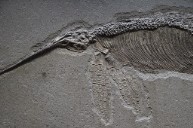
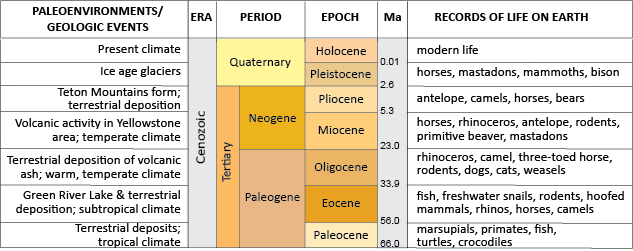
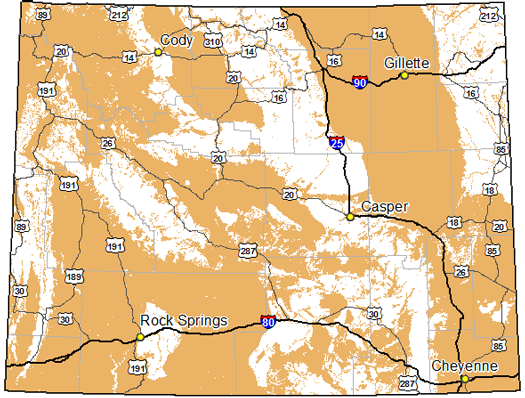
Cenozoic Fossil Record
The Cenozoic Era is sometimes referred to as the "Age of Mammals." It was during this stretch of geologic time that the variety of terrestrial animals began to expand and
the continents began to take their present shape and distribution.
Tertiary sediments are widespread in Wyoming. The climate during the Tertiary supported growth of thick forests. As a result, plant fossils are common in rocks from this
period. Much of Wyoming's economic coal deposits are found in Tertiary sediments. Marsupials, primates, and hoofed mammals, such as antelope and camels, begin to appear in
the fossil record. Other Tertiary terrestrial life includes bears, mastadons, rodents, cats, and dogs. Of particular significance in the Tertiary fossil record of Wyoming
is the Green River Formation. This
formation was deposited on the floor of an ancient lake (Lake Gosiute). It is recognized for its well-preserved fish fossils, including Knightia, the Wyoming State
Fossil. The Green River Formation also bears fossil bats, plants, invertebrates, and vertebrates.
In the Quaternary, several periods of glaciation occurred in Wyoming. Mammoths, mastadons, bison, and horses are some of the animals that have been found in Wyoming's Quaternary
fossil record.
